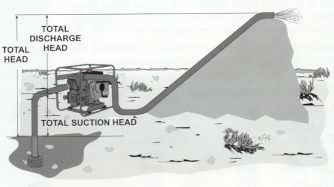Max Head
"Max head" or "Total head" is the vertical distance upwards that you are trying to move the water. If a pump is rated with a max head of 14 feet it doesn't mean you are restricted to a 14 foot discharge hose/pipe, you can use a 300 foot hose/pipe so long as the final destination of the water is not 14 feet or more above the original source. There is no way around this limit - if you have 15 feet to go upwards from source to destination it makes no difference whether the pump is down at the same level as the water source or 5 feet above it - the pump still has to move that water 15 feet.

The head has a large impact on the flow rate (gallons per minute = GPM or gallons per hour = GPH) you will get out of the pump. Always be careful to check the performance graph of the pump. We list a performance graph on the "full spec" page of every pump. Reading it is easy. Locate the height in feet you are interested in and read across until you see the gallons per minute/hour reading for that height.
 Click here to go back to previous page
Click here to go back to previous page
Suction Lift
"Suction lift" is the maximum distance the pump can be above the water source (not relevant for submersible pumps). Not the distance between the pump and the water (which can be upwards of 300 feet) but the actual height difference (usually limited to 25 feet at sea level). Suction is explained in more detail (including diagrams) on our online pump theory page.
Click here to go back to previous page
GPH or GPM flow rate
This is ONE figure for flow from a pump. It is provided by the manufacturer. In actuality there is a "flow rate range" available from your pump and the rate you will get depends enormously on the height you will be pumping the water to.
Always be careful to check the performance graph of the pump. We list a performance graph on the "full spec" page of every pump. Reading it is easy. Locate the height in feet you are interested in and read across until you see the gallons per minute/hour reading for that height.
 Click here to go back to previous page
Click here to go back to previous page
Electrical rating
115V single phase and 110V single phase are one and the same. It is the power you get when you use a standard wall outlet in the US and canada. Some sources will list 110V while others will list 115V.
230V single phase is the same as 220V. This can be acheived in a residence but normally requires an electrician to run a new line from the fuse box (like the one that goes to the stove).
Any power rating that mentions three phase is not residential grade - check with your electrician before purchasing. Some of the larger electric pumps require this amount of power.
Click here to go back to previous page
Minimum water level
The design of some pumps is such that letting them run dry (or partially dry) for extended periods of time will cause damage to the pump. If you think that the water level will drop beneath the "minimum water level" rating for a pump, your options are to connect the pump to a float switch so the pump turns off when the water level drops or to select a different style of pump.
Click here to go back to previous page
Amps (starting / running)
Electric pumps usually have two definitions for their amps usage. Starting and running. Don't be put off by the starting amp figure. Every electric motor uses more amps when you first turn it on for a brief instant - it is called the initial in-rush.
Click here to go back to previous page
|



